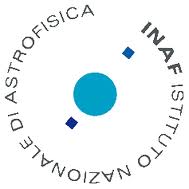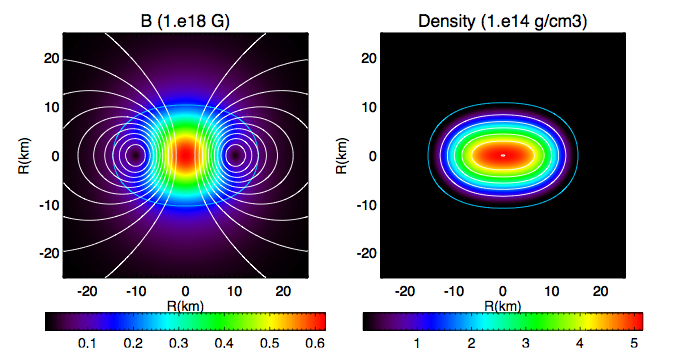
The NSMAG project designed to study and model the properties of magnetized neutron stars. The research is a founded by the European Union under a FP7 Career Integration Grant awarded in 2012 to Niccolò Bucciantini at the INAF-Osservatorio di Arcetri (Italy). The aim of the project is to develope a set ofBucciantini at the INAF-Osservatorio di Arcetri (Italy). The aim of the project is to develop a set of tools to investigate the physics of stron magnetic field applied to Neutron Star, both for what concern the modification that these fields introduce in the structure of these objects (modification the can lead to observable properties), both to address the dynamics of the field itself in the strong gravity characterizing these systems.

It is a well known fact in many different research areas, from physics to biology, from astronomy to geology, that magnetic fields can alter the behavior of matter in ways that are all but trivial: challenging in their understanding, and exciting in their promised outcomes. However, as soon as one realizes that the strongest magnetic fields achieved and maintained in our labs are only few thousands times stronger than what one can find in a common home-appliance, it is evident that astronomical objects are the only available laboratories to study magnetic phenomena in their truly extreme manifestations: only in the sky we observe those unique conditions, that can boost the frontier of our knowledge in unexpected ways. Among the many different classes of stellar objects, Neutron Stars (NSs) provide a unique environment where we can test (at the same time) our understanding of matter with extreme density, temperature, and magnetic fields. Neutron Stars are the hottest superconductors and superfluids in the Universe. Their equation of state is almost a century long debated issue in Condensed Matter Physics. They are prime candidates for future high- energy gamma-ray and X-ray space missions. They are considered among the most promising sources of detectable Gravitational Waves, and High Energy Cosmic Rays.
Neutron Stars are what is left after a massive star terminates its life in a Supernova Explosion (SN). The star's core collapses, confining about one solar mass into an object of about 10 km radius, the size of a large city. Such an object often rotates at a fraction of the speed of light, and we know it can easily posses a magnetic fields ten orders of magnitude higher that what we can reach on Earth. The existence of NSs as degenerate stars was already suggested in the 1930s by Chandrasekhar. But it was only in the '60 that the detection of the first radio pulsar provided observational evidence that such stars indeed exist. The role of rotation and magnetic fields was immediately evident: without these they would have probably remained undetected for other 40 years. Now we know about two thousand radio pulsars, and new classes of NSs have been found, where again the magnetic field manifests itself in different ways. Among them two new classes, namely the Soft Gamma Repeaters (SGR) and the Anomalous X-ray Pulsars (AXP), have drawn large interest. SGRs were discovered as flaring sources by large field-of-view X- and gamma-ray instruments. They exhibit peculiar X- ray bursts lasting 0.01-100s with luminosities up to billions of times higher than that of our Sun. AXPs, instead, were observed as steady, radio-quiet X-ray sources with long rotation periods. What is intriguing is that the phenomenology of these objects can only be explained by the presence of magnetic fields hundreds of trillions of times stronger than the Earth's magnetic field, and thousands of times those of canonical pulsars, making them the strongest magnets in the Universe. These systems are called "magnetars".

Understanding the role of the magnetic field in NSs, developing the tools necessary for its correct modeling in those extreme conditions (strong gravity, high density, relativistic motions) and being able to follow its dynamics, has important consequences also for our understanding of other astrophysical systems. Strong magnetic fields play a crucial role in many high-energy astrophysical scenarios containing compact objects. They are believed to be the key element in the context of Gamma Ray Bursts (GRBs), AGN jets, magnetars, and their dissipation and reconnection to be at the origin of many typical high-energy phenomena. Large scale ordered magnetic fields are in fact crucial to power many high-energy systems. Strong magnetic fields close to the central black hole (BH) in accretion disks are invoked to explain the launching of relativistic jets. The pulsar and magnetar paradigms require strong dipolar magnetic fields in Neutron Stars. Magnetic stresses

A specific initiative within CSN4 - INFN (Istituto Nazionale di Fisica Nucleare), named TEONGRAV (TEOria delle ONde GRAVitazionali - Gravitational Waves Theory) and led by Dr. Leonardo Gualtieri (Roma, La Sapienza), has a node in Firenze led by Luca Del Zanna on the project "Sources of gravitational waves". The development of numerical tools for plasma physics and MHD in curved and dynamical spacetimes and, in particular, the detailed modeling of general relativistic MHD equilibrium models for rotating and strongly magnetized neutron stars is the main objective of the initiative.
The code XNS solves for the axisymmetric equilibrium configuration of Neutron Star in general Relativity. It allows to include and model differentially rotating and magnetic fields either purely toroidal, purely poloidal or in the mixed Twisted Torus configuration. Einsten's equations are solved using the XCFC approximation for the metric, in spherical coordinates. The code is based on the metric module and routines developed for the GR-MHD code X-ECHO.

There are several other codes published in the years (RNS, RotStar, etc....) you might want to check. However, solutions, even for rapid rotators close to the mass shedding limit, show that the difference between conformally flat metric CFC/XCFC, and the more appropriate quasi-isotropic coordinates is order of 0.1% (larger differences are expected for strongly distorted cases of disk-like configurations), so in principle one would expect the CFC/XCFC limit to provide a reasonably good approximation of the correct solution for Neutron Stars. There are some computational benefits in using XCFC over quasi-isotropic coordinates, and as an Astrophysicist I am looking more toward a solution that is physically acceptable than one that is mathematically correct.